Business Environment Report: TESCO's Environment and Business Impact
VerifiedAdded on 2020/06/06
|16
|5026
|63
Report
AI Summary
This report provides a comprehensive analysis of the business environment, focusing on company types (public, private, and voluntary sectors) and their legal structures. It includes an examination of the size and scope of various organizations, with a specific case study of TESCO, a leading multinational grocery retailer. The report explores the relationship between organizational functions, such as marketing and human resources, and their impact on business objectives. It also analyzes the positive and negative impacts of the macro-environment, including a PESTEL analysis, and identifies internal and external factors that influence organizational strengths and weaknesses. The report concludes with an overview of the key findings and their implications for business strategy.
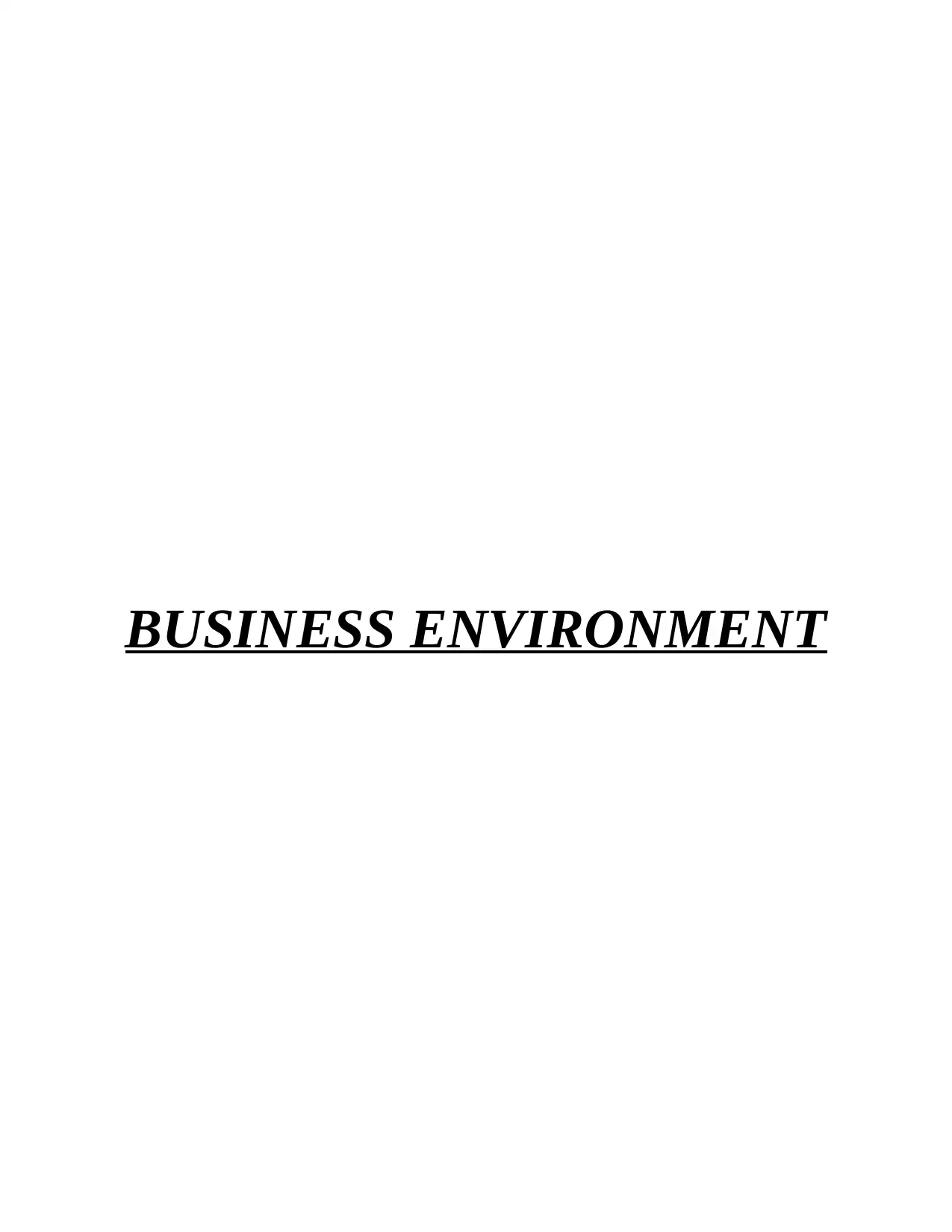
BUSINESS ENVIRONMENT
Paraphrase This Document
Need a fresh take? Get an instant paraphrase of this document with our AI Paraphraser
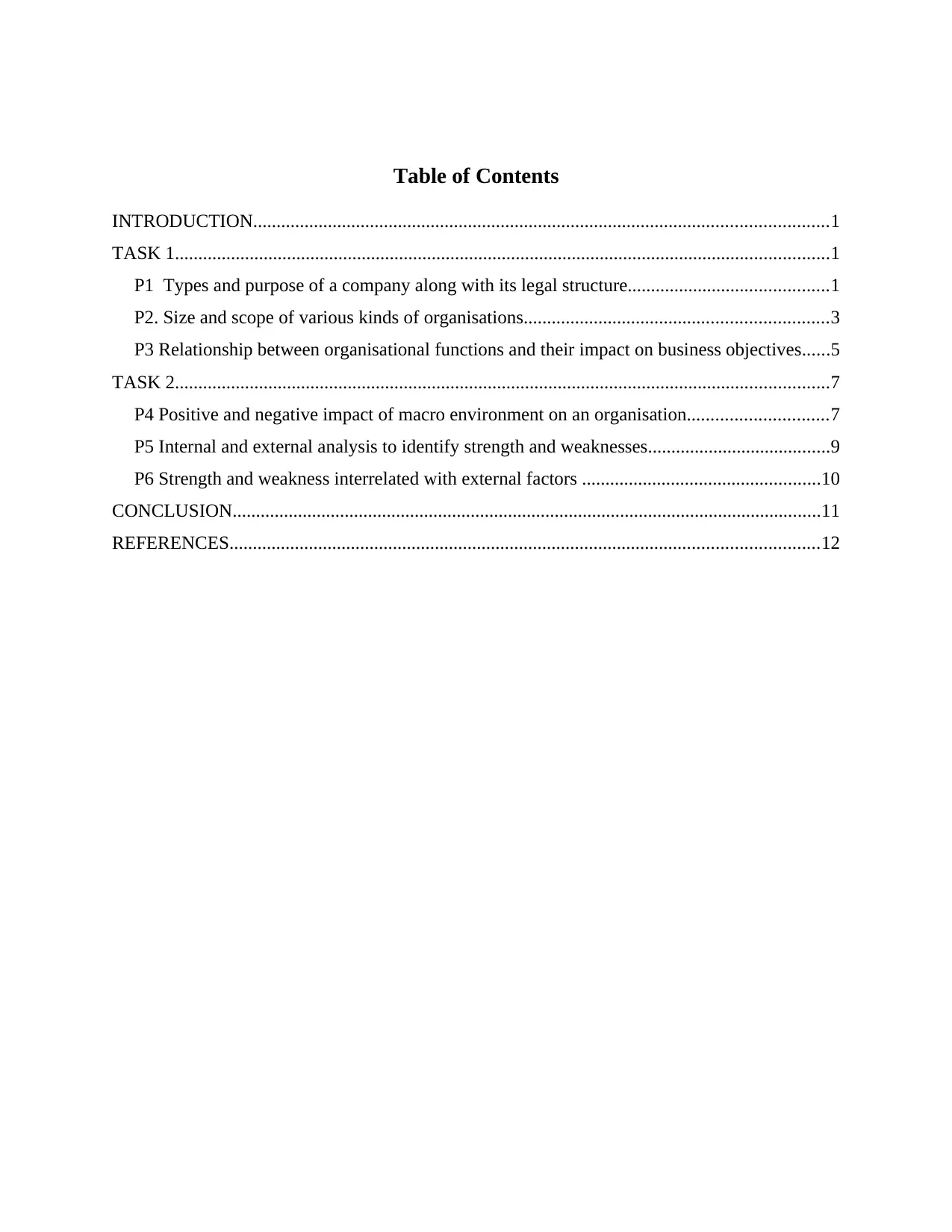
Table of Contents
INTRODUCTION...........................................................................................................................1
TASK 1............................................................................................................................................1
P1 Types and purpose of a company along with its legal structure...........................................1
P2. Size and scope of various kinds of organisations.................................................................3
P3 Relationship between organisational functions and their impact on business objectives......5
TASK 2............................................................................................................................................7
P4 Positive and negative impact of macro environment on an organisation..............................7
P5 Internal and external analysis to identify strength and weaknesses.......................................9
P6 Strength and weakness interrelated with external factors ...................................................10
CONCLUSION..............................................................................................................................11
REFERENCES..............................................................................................................................12
INTRODUCTION...........................................................................................................................1
TASK 1............................................................................................................................................1
P1 Types and purpose of a company along with its legal structure...........................................1
P2. Size and scope of various kinds of organisations.................................................................3
P3 Relationship between organisational functions and their impact on business objectives......5
TASK 2............................................................................................................................................7
P4 Positive and negative impact of macro environment on an organisation..............................7
P5 Internal and external analysis to identify strength and weaknesses.......................................9
P6 Strength and weakness interrelated with external factors ...................................................10
CONCLUSION..............................................................................................................................11
REFERENCES..............................................................................................................................12
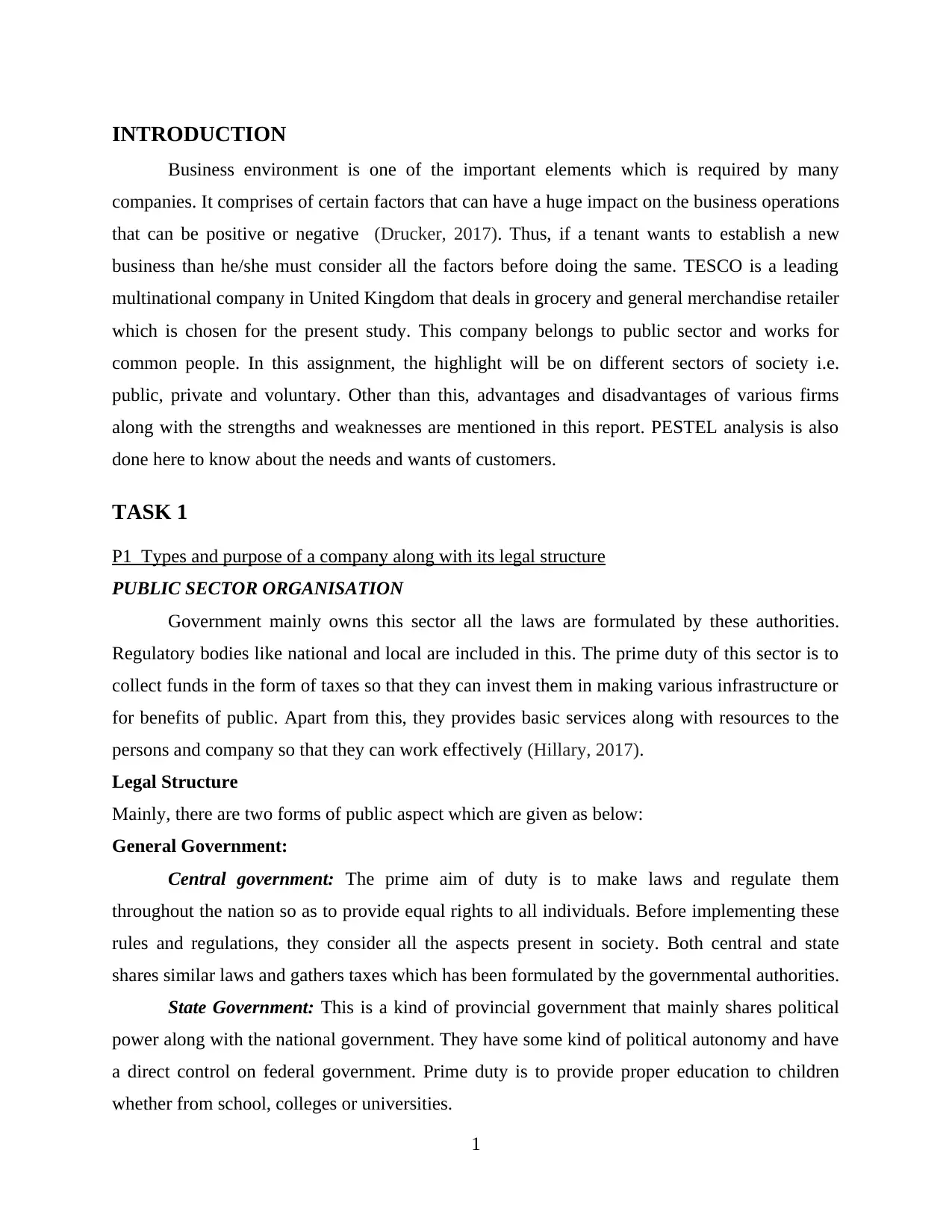
INTRODUCTION
Business environment is one of the important elements which is required by many
companies. It comprises of certain factors that can have a huge impact on the business operations
that can be positive or negative (Drucker, 2017). Thus, if a tenant wants to establish a new
business than he/she must consider all the factors before doing the same. TESCO is a leading
multinational company in United Kingdom that deals in grocery and general merchandise retailer
which is chosen for the present study. This company belongs to public sector and works for
common people. In this assignment, the highlight will be on different sectors of society i.e.
public, private and voluntary. Other than this, advantages and disadvantages of various firms
along with the strengths and weaknesses are mentioned in this report. PESTEL analysis is also
done here to know about the needs and wants of customers.
TASK 1
P1 Types and purpose of a company along with its legal structure
PUBLIC SECTOR ORGANISATION
Government mainly owns this sector all the laws are formulated by these authorities.
Regulatory bodies like national and local are included in this. The prime duty of this sector is to
collect funds in the form of taxes so that they can invest them in making various infrastructure or
for benefits of public. Apart from this, they provides basic services along with resources to the
persons and company so that they can work effectively (Hillary, 2017).
Legal Structure
Mainly, there are two forms of public aspect which are given as below:
General Government:
Central government: The prime aim of duty is to make laws and regulate them
throughout the nation so as to provide equal rights to all individuals. Before implementing these
rules and regulations, they consider all the aspects present in society. Both central and state
shares similar laws and gathers taxes which has been formulated by the governmental authorities.
State Government: This is a kind of provincial government that mainly shares political
power along with the national government. They have some kind of political autonomy and have
a direct control on federal government. Prime duty is to provide proper education to children
whether from school, colleges or universities.
1
Business environment is one of the important elements which is required by many
companies. It comprises of certain factors that can have a huge impact on the business operations
that can be positive or negative (Drucker, 2017). Thus, if a tenant wants to establish a new
business than he/she must consider all the factors before doing the same. TESCO is a leading
multinational company in United Kingdom that deals in grocery and general merchandise retailer
which is chosen for the present study. This company belongs to public sector and works for
common people. In this assignment, the highlight will be on different sectors of society i.e.
public, private and voluntary. Other than this, advantages and disadvantages of various firms
along with the strengths and weaknesses are mentioned in this report. PESTEL analysis is also
done here to know about the needs and wants of customers.
TASK 1
P1 Types and purpose of a company along with its legal structure
PUBLIC SECTOR ORGANISATION
Government mainly owns this sector all the laws are formulated by these authorities.
Regulatory bodies like national and local are included in this. The prime duty of this sector is to
collect funds in the form of taxes so that they can invest them in making various infrastructure or
for benefits of public. Apart from this, they provides basic services along with resources to the
persons and company so that they can work effectively (Hillary, 2017).
Legal Structure
Mainly, there are two forms of public aspect which are given as below:
General Government:
Central government: The prime aim of duty is to make laws and regulate them
throughout the nation so as to provide equal rights to all individuals. Before implementing these
rules and regulations, they consider all the aspects present in society. Both central and state
shares similar laws and gathers taxes which has been formulated by the governmental authorities.
State Government: This is a kind of provincial government that mainly shares political
power along with the national government. They have some kind of political autonomy and have
a direct control on federal government. Prime duty is to provide proper education to children
whether from school, colleges or universities.
1
⊘ This is a preview!⊘
Do you want full access?
Subscribe today to unlock all pages.

Trusted by 1+ million students worldwide
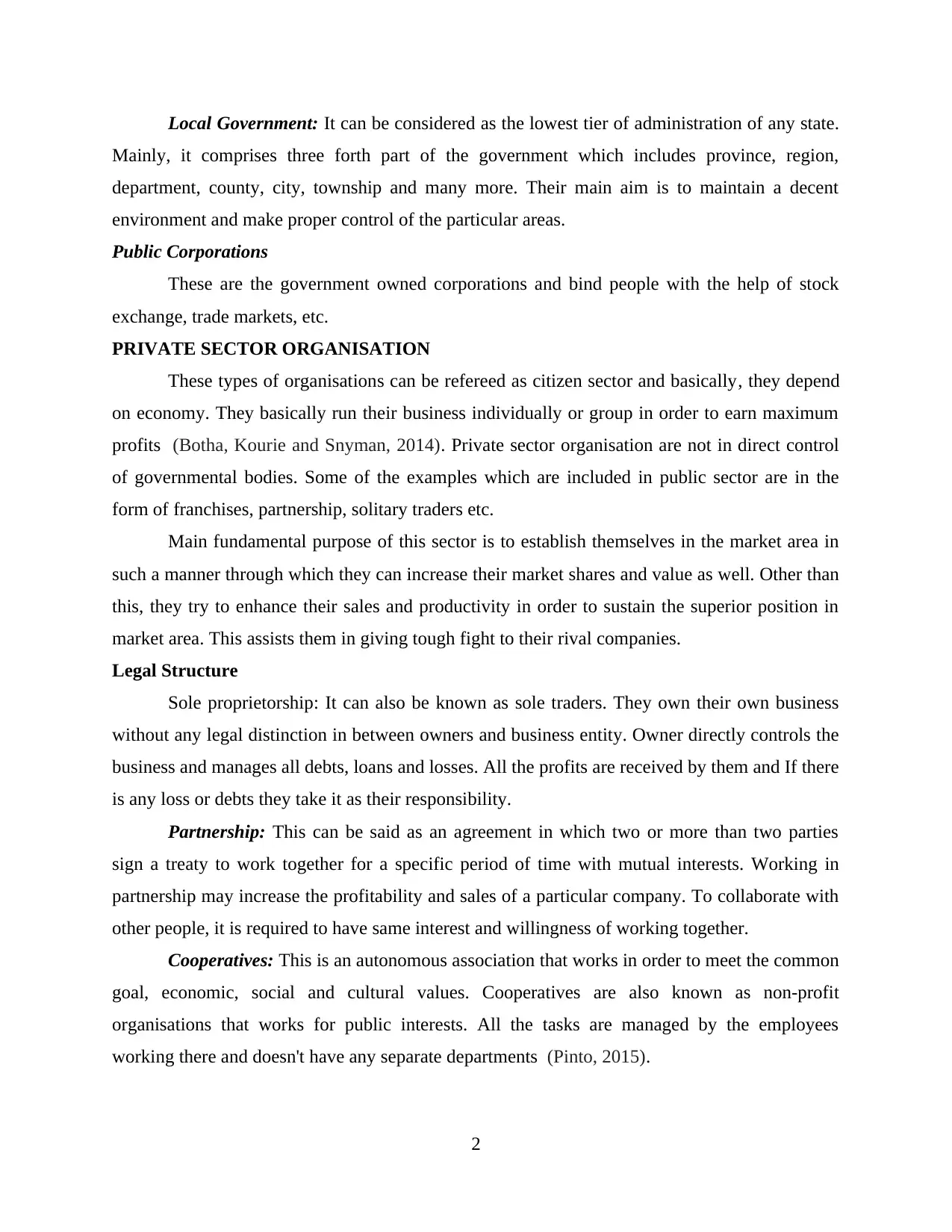
Local Government: It can be considered as the lowest tier of administration of any state.
Mainly, it comprises three forth part of the government which includes province, region,
department, county, city, township and many more. Their main aim is to maintain a decent
environment and make proper control of the particular areas.
Public Corporations
These are the government owned corporations and bind people with the help of stock
exchange, trade markets, etc.
PRIVATE SECTOR ORGANISATION
These types of organisations can be refereed as citizen sector and basically, they depend
on economy. They basically run their business individually or group in order to earn maximum
profits (Botha, Kourie and Snyman, 2014). Private sector organisation are not in direct control
of governmental bodies. Some of the examples which are included in public sector are in the
form of franchises, partnership, solitary traders etc.
Main fundamental purpose of this sector is to establish themselves in the market area in
such a manner through which they can increase their market shares and value as well. Other than
this, they try to enhance their sales and productivity in order to sustain the superior position in
market area. This assists them in giving tough fight to their rival companies.
Legal Structure
Sole proprietorship: It can also be known as sole traders. They own their own business
without any legal distinction in between owners and business entity. Owner directly controls the
business and manages all debts, loans and losses. All the profits are received by them and If there
is any loss or debts they take it as their responsibility.
Partnership: This can be said as an agreement in which two or more than two parties
sign a treaty to work together for a specific period of time with mutual interests. Working in
partnership may increase the profitability and sales of a particular company. To collaborate with
other people, it is required to have same interest and willingness of working together.
Cooperatives: This is an autonomous association that works in order to meet the common
goal, economic, social and cultural values. Cooperatives are also known as non-profit
organisations that works for public interests. All the tasks are managed by the employees
working there and doesn't have any separate departments (Pinto, 2015).
2
Mainly, it comprises three forth part of the government which includes province, region,
department, county, city, township and many more. Their main aim is to maintain a decent
environment and make proper control of the particular areas.
Public Corporations
These are the government owned corporations and bind people with the help of stock
exchange, trade markets, etc.
PRIVATE SECTOR ORGANISATION
These types of organisations can be refereed as citizen sector and basically, they depend
on economy. They basically run their business individually or group in order to earn maximum
profits (Botha, Kourie and Snyman, 2014). Private sector organisation are not in direct control
of governmental bodies. Some of the examples which are included in public sector are in the
form of franchises, partnership, solitary traders etc.
Main fundamental purpose of this sector is to establish themselves in the market area in
such a manner through which they can increase their market shares and value as well. Other than
this, they try to enhance their sales and productivity in order to sustain the superior position in
market area. This assists them in giving tough fight to their rival companies.
Legal Structure
Sole proprietorship: It can also be known as sole traders. They own their own business
without any legal distinction in between owners and business entity. Owner directly controls the
business and manages all debts, loans and losses. All the profits are received by them and If there
is any loss or debts they take it as their responsibility.
Partnership: This can be said as an agreement in which two or more than two parties
sign a treaty to work together for a specific period of time with mutual interests. Working in
partnership may increase the profitability and sales of a particular company. To collaborate with
other people, it is required to have same interest and willingness of working together.
Cooperatives: This is an autonomous association that works in order to meet the common
goal, economic, social and cultural values. Cooperatives are also known as non-profit
organisations that works for public interests. All the tasks are managed by the employees
working there and doesn't have any separate departments (Pinto, 2015).
2
Paraphrase This Document
Need a fresh take? Get an instant paraphrase of this document with our AI Paraphraser
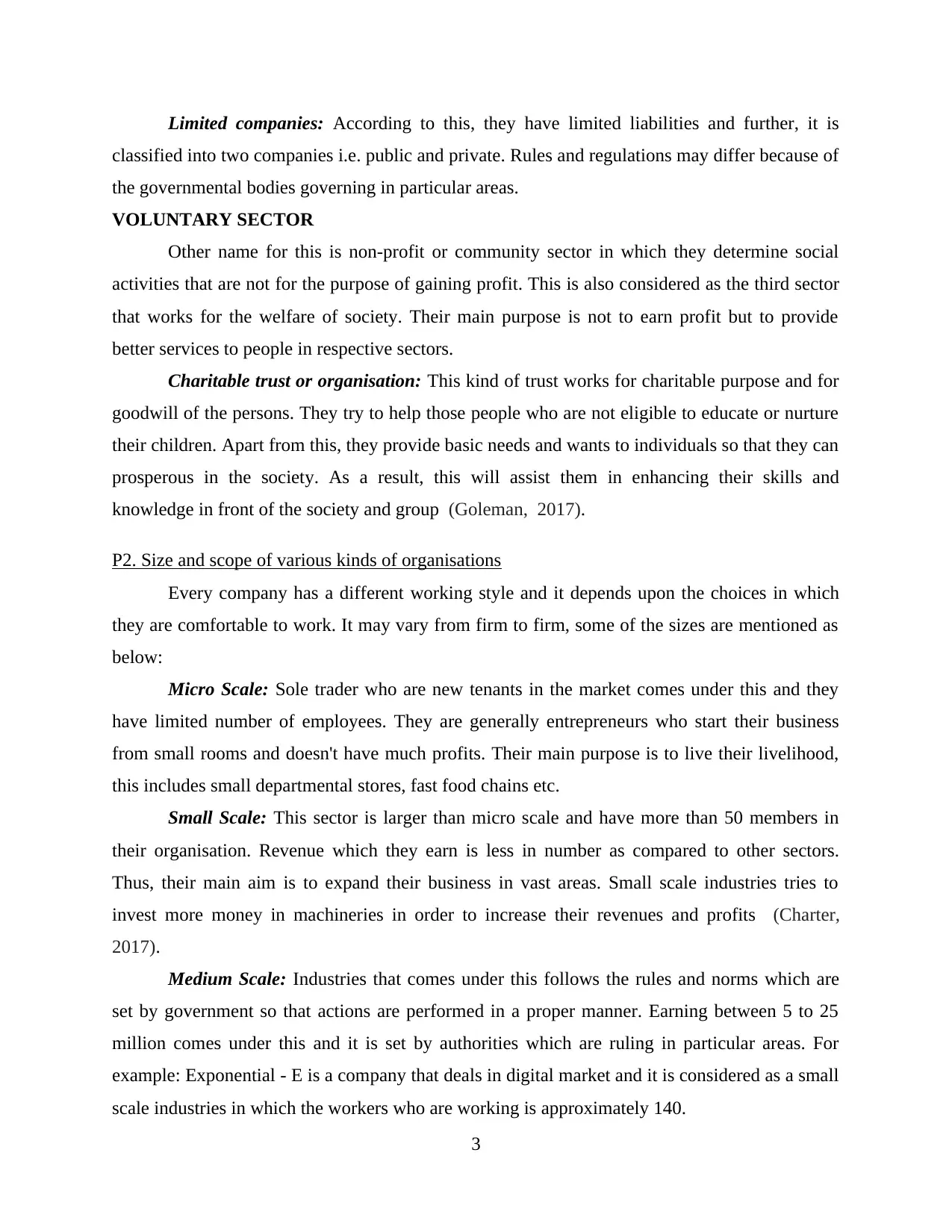
Limited companies: According to this, they have limited liabilities and further, it is
classified into two companies i.e. public and private. Rules and regulations may differ because of
the governmental bodies governing in particular areas.
VOLUNTARY SECTOR
Other name for this is non-profit or community sector in which they determine social
activities that are not for the purpose of gaining profit. This is also considered as the third sector
that works for the welfare of society. Their main purpose is not to earn profit but to provide
better services to people in respective sectors.
Charitable trust or organisation: This kind of trust works for charitable purpose and for
goodwill of the persons. They try to help those people who are not eligible to educate or nurture
their children. Apart from this, they provide basic needs and wants to individuals so that they can
prosperous in the society. As a result, this will assist them in enhancing their skills and
knowledge in front of the society and group (Goleman, 2017).
P2. Size and scope of various kinds of organisations
Every company has a different working style and it depends upon the choices in which
they are comfortable to work. It may vary from firm to firm, some of the sizes are mentioned as
below:
Micro Scale: Sole trader who are new tenants in the market comes under this and they
have limited number of employees. They are generally entrepreneurs who start their business
from small rooms and doesn't have much profits. Their main purpose is to live their livelihood,
this includes small departmental stores, fast food chains etc.
Small Scale: This sector is larger than micro scale and have more than 50 members in
their organisation. Revenue which they earn is less in number as compared to other sectors.
Thus, their main aim is to expand their business in vast areas. Small scale industries tries to
invest more money in machineries in order to increase their revenues and profits (Charter,
2017).
Medium Scale: Industries that comes under this follows the rules and norms which are
set by government so that actions are performed in a proper manner. Earning between 5 to 25
million comes under this and it is set by authorities which are ruling in particular areas. For
example: Exponential - E is a company that deals in digital market and it is considered as a small
scale industries in which the workers who are working is approximately 140.
3
classified into two companies i.e. public and private. Rules and regulations may differ because of
the governmental bodies governing in particular areas.
VOLUNTARY SECTOR
Other name for this is non-profit or community sector in which they determine social
activities that are not for the purpose of gaining profit. This is also considered as the third sector
that works for the welfare of society. Their main purpose is not to earn profit but to provide
better services to people in respective sectors.
Charitable trust or organisation: This kind of trust works for charitable purpose and for
goodwill of the persons. They try to help those people who are not eligible to educate or nurture
their children. Apart from this, they provide basic needs and wants to individuals so that they can
prosperous in the society. As a result, this will assist them in enhancing their skills and
knowledge in front of the society and group (Goleman, 2017).
P2. Size and scope of various kinds of organisations
Every company has a different working style and it depends upon the choices in which
they are comfortable to work. It may vary from firm to firm, some of the sizes are mentioned as
below:
Micro Scale: Sole trader who are new tenants in the market comes under this and they
have limited number of employees. They are generally entrepreneurs who start their business
from small rooms and doesn't have much profits. Their main purpose is to live their livelihood,
this includes small departmental stores, fast food chains etc.
Small Scale: This sector is larger than micro scale and have more than 50 members in
their organisation. Revenue which they earn is less in number as compared to other sectors.
Thus, their main aim is to expand their business in vast areas. Small scale industries tries to
invest more money in machineries in order to increase their revenues and profits (Charter,
2017).
Medium Scale: Industries that comes under this follows the rules and norms which are
set by government so that actions are performed in a proper manner. Earning between 5 to 25
million comes under this and it is set by authorities which are ruling in particular areas. For
example: Exponential - E is a company that deals in digital market and it is considered as a small
scale industries in which the workers who are working is approximately 140.
3
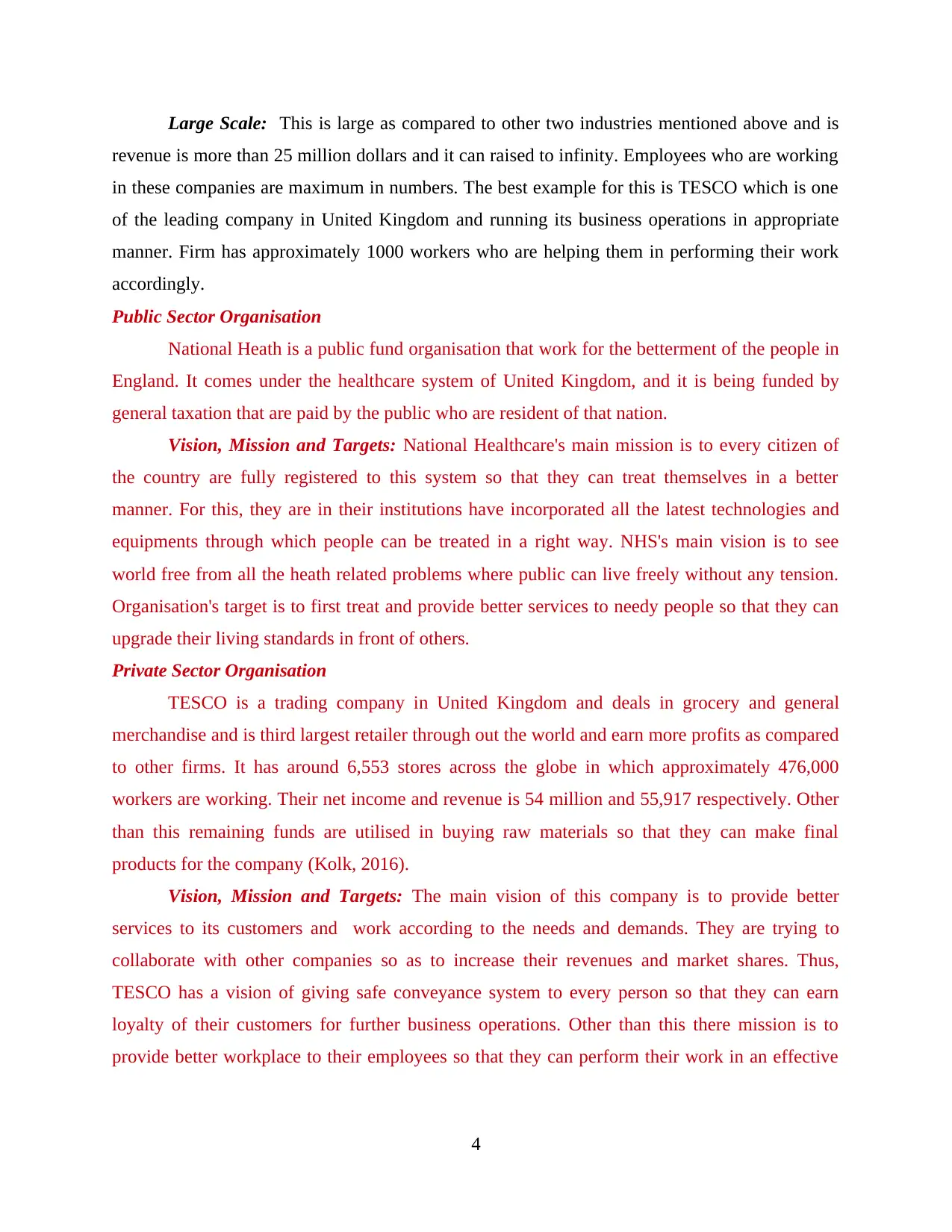
Large Scale: This is large as compared to other two industries mentioned above and is
revenue is more than 25 million dollars and it can raised to infinity. Employees who are working
in these companies are maximum in numbers. The best example for this is TESCO which is one
of the leading company in United Kingdom and running its business operations in appropriate
manner. Firm has approximately 1000 workers who are helping them in performing their work
accordingly.
Public Sector Organisation
National Heath is a public fund organisation that work for the betterment of the people in
England. It comes under the healthcare system of United Kingdom, and it is being funded by
general taxation that are paid by the public who are resident of that nation.
Vision, Mission and Targets: National Healthcare's main mission is to every citizen of
the country are fully registered to this system so that they can treat themselves in a better
manner. For this, they are in their institutions have incorporated all the latest technologies and
equipments through which people can be treated in a right way. NHS's main vision is to see
world free from all the heath related problems where public can live freely without any tension.
Organisation's target is to first treat and provide better services to needy people so that they can
upgrade their living standards in front of others.
Private Sector Organisation
TESCO is a trading company in United Kingdom and deals in grocery and general
merchandise and is third largest retailer through out the world and earn more profits as compared
to other firms. It has around 6,553 stores across the globe in which approximately 476,000
workers are working. Their net income and revenue is 54 million and 55,917 respectively. Other
than this remaining funds are utilised in buying raw materials so that they can make final
products for the company (Kolk, 2016).
Vision, Mission and Targets: The main vision of this company is to provide better
services to its customers and work according to the needs and demands. They are trying to
collaborate with other companies so as to increase their revenues and market shares. Thus,
TESCO has a vision of giving safe conveyance system to every person so that they can earn
loyalty of their customers for further business operations. Other than this there mission is to
provide better workplace to their employees so that they can perform their work in an effective
4
revenue is more than 25 million dollars and it can raised to infinity. Employees who are working
in these companies are maximum in numbers. The best example for this is TESCO which is one
of the leading company in United Kingdom and running its business operations in appropriate
manner. Firm has approximately 1000 workers who are helping them in performing their work
accordingly.
Public Sector Organisation
National Heath is a public fund organisation that work for the betterment of the people in
England. It comes under the healthcare system of United Kingdom, and it is being funded by
general taxation that are paid by the public who are resident of that nation.
Vision, Mission and Targets: National Healthcare's main mission is to every citizen of
the country are fully registered to this system so that they can treat themselves in a better
manner. For this, they are in their institutions have incorporated all the latest technologies and
equipments through which people can be treated in a right way. NHS's main vision is to see
world free from all the heath related problems where public can live freely without any tension.
Organisation's target is to first treat and provide better services to needy people so that they can
upgrade their living standards in front of others.
Private Sector Organisation
TESCO is a trading company in United Kingdom and deals in grocery and general
merchandise and is third largest retailer through out the world and earn more profits as compared
to other firms. It has around 6,553 stores across the globe in which approximately 476,000
workers are working. Their net income and revenue is 54 million and 55,917 respectively. Other
than this remaining funds are utilised in buying raw materials so that they can make final
products for the company (Kolk, 2016).
Vision, Mission and Targets: The main vision of this company is to provide better
services to its customers and work according to the needs and demands. They are trying to
collaborate with other companies so as to increase their revenues and market shares. Thus,
TESCO has a vision of giving safe conveyance system to every person so that they can earn
loyalty of their customers for further business operations. Other than this there mission is to
provide better workplace to their employees so that they can perform their work in an effective
4
⊘ This is a preview!⊘
Do you want full access?
Subscribe today to unlock all pages.

Trusted by 1+ million students worldwide
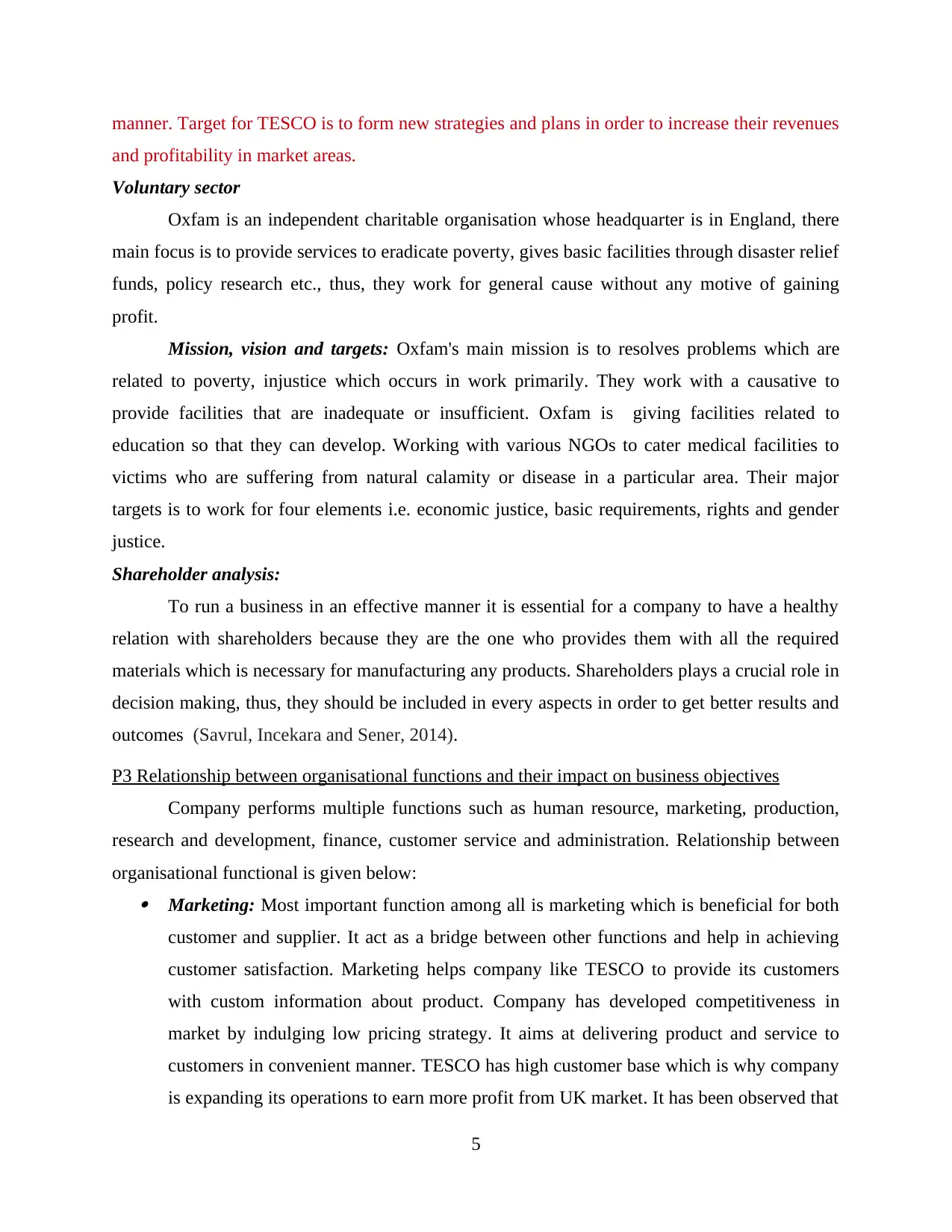
manner. Target for TESCO is to form new strategies and plans in order to increase their revenues
and profitability in market areas.
Voluntary sector
Oxfam is an independent charitable organisation whose headquarter is in England, there
main focus is to provide services to eradicate poverty, gives basic facilities through disaster relief
funds, policy research etc., thus, they work for general cause without any motive of gaining
profit.
Mission, vision and targets: Oxfam's main mission is to resolves problems which are
related to poverty, injustice which occurs in work primarily. They work with a causative to
provide facilities that are inadequate or insufficient. Oxfam is giving facilities related to
education so that they can develop. Working with various NGOs to cater medical facilities to
victims who are suffering from natural calamity or disease in a particular area. Their major
targets is to work for four elements i.e. economic justice, basic requirements, rights and gender
justice.
Shareholder analysis:
To run a business in an effective manner it is essential for a company to have a healthy
relation with shareholders because they are the one who provides them with all the required
materials which is necessary for manufacturing any products. Shareholders plays a crucial role in
decision making, thus, they should be included in every aspects in order to get better results and
outcomes (Savrul, Incekara and Sener, 2014).
P3 Relationship between organisational functions and their impact on business objectives
Company performs multiple functions such as human resource, marketing, production,
research and development, finance, customer service and administration. Relationship between
organisational functional is given below: Marketing: Most important function among all is marketing which is beneficial for both
customer and supplier. It act as a bridge between other functions and help in achieving
customer satisfaction. Marketing helps company like TESCO to provide its customers
with custom information about product. Company has developed competitiveness in
market by indulging low pricing strategy. It aims at delivering product and service to
customers in convenient manner. TESCO has high customer base which is why company
is expanding its operations to earn more profit from UK market. It has been observed that
5
and profitability in market areas.
Voluntary sector
Oxfam is an independent charitable organisation whose headquarter is in England, there
main focus is to provide services to eradicate poverty, gives basic facilities through disaster relief
funds, policy research etc., thus, they work for general cause without any motive of gaining
profit.
Mission, vision and targets: Oxfam's main mission is to resolves problems which are
related to poverty, injustice which occurs in work primarily. They work with a causative to
provide facilities that are inadequate or insufficient. Oxfam is giving facilities related to
education so that they can develop. Working with various NGOs to cater medical facilities to
victims who are suffering from natural calamity or disease in a particular area. Their major
targets is to work for four elements i.e. economic justice, basic requirements, rights and gender
justice.
Shareholder analysis:
To run a business in an effective manner it is essential for a company to have a healthy
relation with shareholders because they are the one who provides them with all the required
materials which is necessary for manufacturing any products. Shareholders plays a crucial role in
decision making, thus, they should be included in every aspects in order to get better results and
outcomes (Savrul, Incekara and Sener, 2014).
P3 Relationship between organisational functions and their impact on business objectives
Company performs multiple functions such as human resource, marketing, production,
research and development, finance, customer service and administration. Relationship between
organisational functional is given below: Marketing: Most important function among all is marketing which is beneficial for both
customer and supplier. It act as a bridge between other functions and help in achieving
customer satisfaction. Marketing helps company like TESCO to provide its customers
with custom information about product. Company has developed competitiveness in
market by indulging low pricing strategy. It aims at delivering product and service to
customers in convenient manner. TESCO has high customer base which is why company
is expanding its operations to earn more profit from UK market. It has been observed that
5
Paraphrase This Document
Need a fresh take? Get an instant paraphrase of this document with our AI Paraphraser
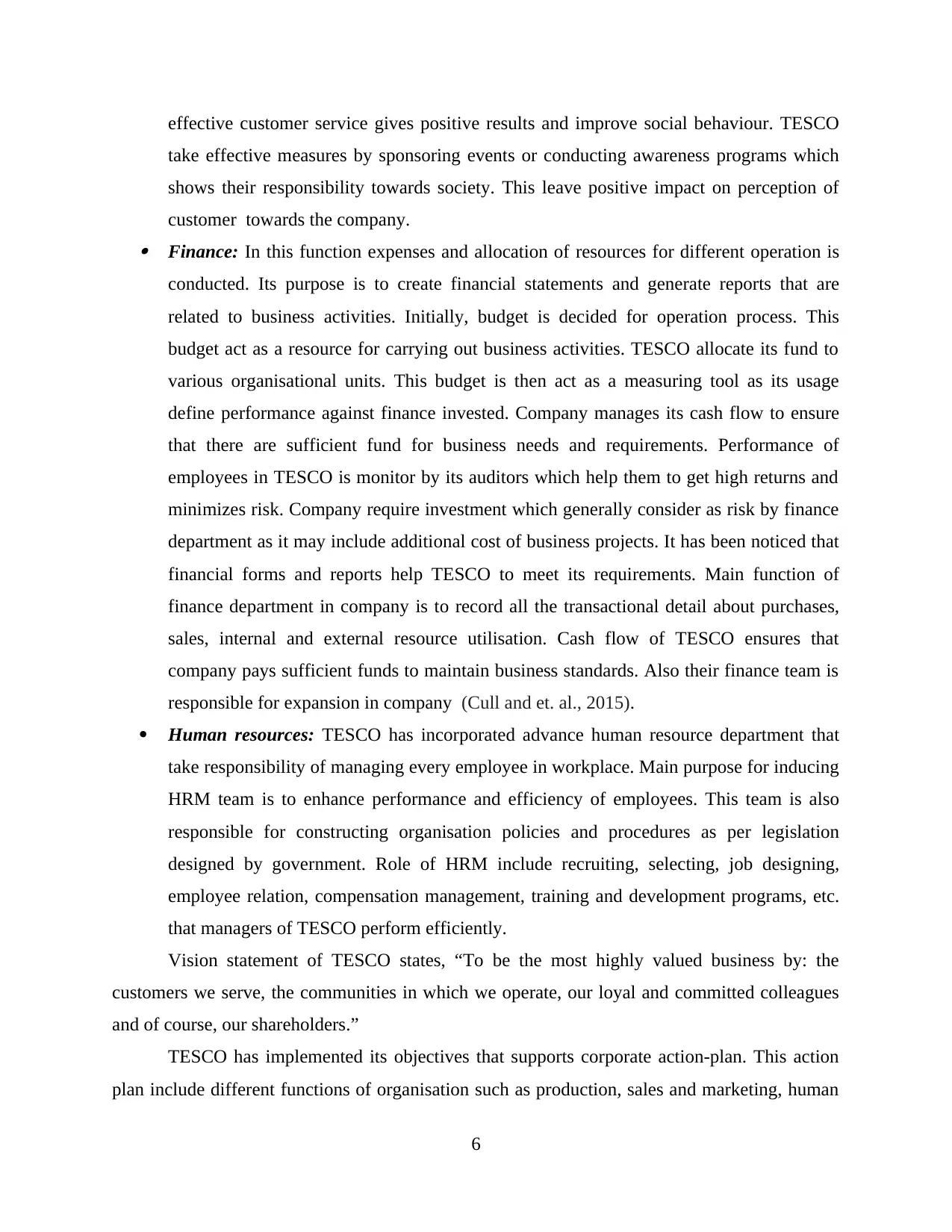
effective customer service gives positive results and improve social behaviour. TESCO
take effective measures by sponsoring events or conducting awareness programs which
shows their responsibility towards society. This leave positive impact on perception of
customer towards the company. Finance: In this function expenses and allocation of resources for different operation is
conducted. Its purpose is to create financial statements and generate reports that are
related to business activities. Initially, budget is decided for operation process. This
budget act as a resource for carrying out business activities. TESCO allocate its fund to
various organisational units. This budget is then act as a measuring tool as its usage
define performance against finance invested. Company manages its cash flow to ensure
that there are sufficient fund for business needs and requirements. Performance of
employees in TESCO is monitor by its auditors which help them to get high returns and
minimizes risk. Company require investment which generally consider as risk by finance
department as it may include additional cost of business projects. It has been noticed that
financial forms and reports help TESCO to meet its requirements. Main function of
finance department in company is to record all the transactional detail about purchases,
sales, internal and external resource utilisation. Cash flow of TESCO ensures that
company pays sufficient funds to maintain business standards. Also their finance team is
responsible for expansion in company (Cull and et. al., 2015).
Human resources: TESCO has incorporated advance human resource department that
take responsibility of managing every employee in workplace. Main purpose for inducing
HRM team is to enhance performance and efficiency of employees. This team is also
responsible for constructing organisation policies and procedures as per legislation
designed by government. Role of HRM include recruiting, selecting, job designing,
employee relation, compensation management, training and development programs, etc.
that managers of TESCO perform efficiently.
Vision statement of TESCO states, “To be the most highly valued business by: the
customers we serve, the communities in which we operate, our loyal and committed colleagues
and of course, our shareholders.”
TESCO has implemented its objectives that supports corporate action-plan. This action
plan include different functions of organisation such as production, sales and marketing, human
6
take effective measures by sponsoring events or conducting awareness programs which
shows their responsibility towards society. This leave positive impact on perception of
customer towards the company. Finance: In this function expenses and allocation of resources for different operation is
conducted. Its purpose is to create financial statements and generate reports that are
related to business activities. Initially, budget is decided for operation process. This
budget act as a resource for carrying out business activities. TESCO allocate its fund to
various organisational units. This budget is then act as a measuring tool as its usage
define performance against finance invested. Company manages its cash flow to ensure
that there are sufficient fund for business needs and requirements. Performance of
employees in TESCO is monitor by its auditors which help them to get high returns and
minimizes risk. Company require investment which generally consider as risk by finance
department as it may include additional cost of business projects. It has been noticed that
financial forms and reports help TESCO to meet its requirements. Main function of
finance department in company is to record all the transactional detail about purchases,
sales, internal and external resource utilisation. Cash flow of TESCO ensures that
company pays sufficient funds to maintain business standards. Also their finance team is
responsible for expansion in company (Cull and et. al., 2015).
Human resources: TESCO has incorporated advance human resource department that
take responsibility of managing every employee in workplace. Main purpose for inducing
HRM team is to enhance performance and efficiency of employees. This team is also
responsible for constructing organisation policies and procedures as per legislation
designed by government. Role of HRM include recruiting, selecting, job designing,
employee relation, compensation management, training and development programs, etc.
that managers of TESCO perform efficiently.
Vision statement of TESCO states, “To be the most highly valued business by: the
customers we serve, the communities in which we operate, our loyal and committed colleagues
and of course, our shareholders.”
TESCO has implemented its objectives that supports corporate action-plan. This action
plan include different functions of organisation such as production, sales and marketing, human
6
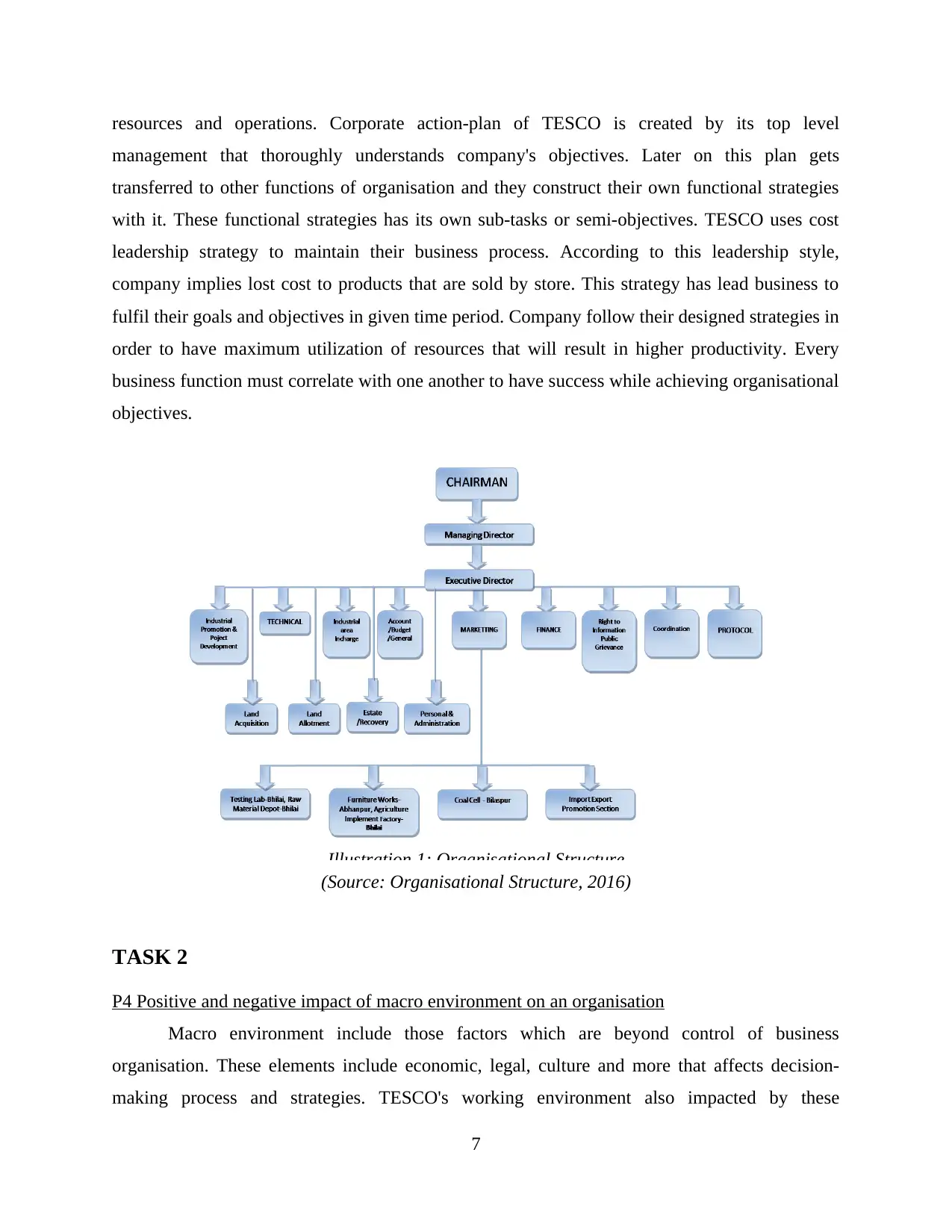
resources and operations. Corporate action-plan of TESCO is created by its top level
management that thoroughly understands company's objectives. Later on this plan gets
transferred to other functions of organisation and they construct their own functional strategies
with it. These functional strategies has its own sub-tasks or semi-objectives. TESCO uses cost
leadership strategy to maintain their business process. According to this leadership style,
company implies lost cost to products that are sold by store. This strategy has lead business to
fulfil their goals and objectives in given time period. Company follow their designed strategies in
order to have maximum utilization of resources that will result in higher productivity. Every
business function must correlate with one another to have success while achieving organisational
objectives.
(Source: Organisational Structure, 2016)
TASK 2
P4 Positive and negative impact of macro environment on an organisation
Macro environment include those factors which are beyond control of business
organisation. These elements include economic, legal, culture and more that affects decision-
making process and strategies. TESCO's working environment also impacted by these
7
Illustration 1: Organisational Structure
management that thoroughly understands company's objectives. Later on this plan gets
transferred to other functions of organisation and they construct their own functional strategies
with it. These functional strategies has its own sub-tasks or semi-objectives. TESCO uses cost
leadership strategy to maintain their business process. According to this leadership style,
company implies lost cost to products that are sold by store. This strategy has lead business to
fulfil their goals and objectives in given time period. Company follow their designed strategies in
order to have maximum utilization of resources that will result in higher productivity. Every
business function must correlate with one another to have success while achieving organisational
objectives.
(Source: Organisational Structure, 2016)
TASK 2
P4 Positive and negative impact of macro environment on an organisation
Macro environment include those factors which are beyond control of business
organisation. These elements include economic, legal, culture and more that affects decision-
making process and strategies. TESCO's working environment also impacted by these
7
Illustration 1: Organisational Structure
⊘ This is a preview!⊘
Do you want full access?
Subscribe today to unlock all pages.

Trusted by 1+ million students worldwide
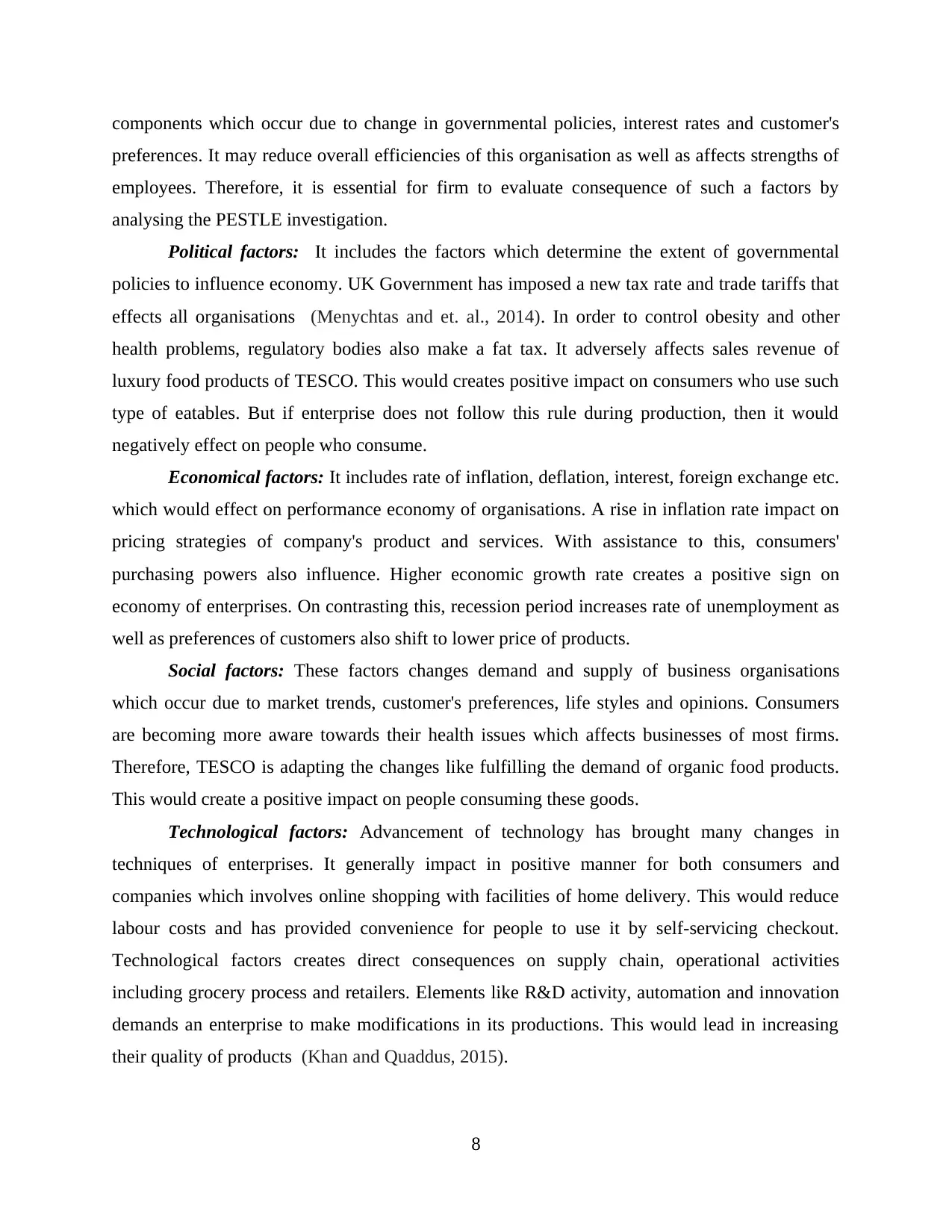
components which occur due to change in governmental policies, interest rates and customer's
preferences. It may reduce overall efficiencies of this organisation as well as affects strengths of
employees. Therefore, it is essential for firm to evaluate consequence of such a factors by
analysing the PESTLE investigation.
Political factors: It includes the factors which determine the extent of governmental
policies to influence economy. UK Government has imposed a new tax rate and trade tariffs that
effects all organisations (Menychtas and et. al., 2014). In order to control obesity and other
health problems, regulatory bodies also make a fat tax. It adversely affects sales revenue of
luxury food products of TESCO. This would creates positive impact on consumers who use such
type of eatables. But if enterprise does not follow this rule during production, then it would
negatively effect on people who consume.
Economical factors: It includes rate of inflation, deflation, interest, foreign exchange etc.
which would effect on performance economy of organisations. A rise in inflation rate impact on
pricing strategies of company's product and services. With assistance to this, consumers'
purchasing powers also influence. Higher economic growth rate creates a positive sign on
economy of enterprises. On contrasting this, recession period increases rate of unemployment as
well as preferences of customers also shift to lower price of products.
Social factors: These factors changes demand and supply of business organisations
which occur due to market trends, customer's preferences, life styles and opinions. Consumers
are becoming more aware towards their health issues which affects businesses of most firms.
Therefore, TESCO is adapting the changes like fulfilling the demand of organic food products.
This would create a positive impact on people consuming these goods.
Technological factors: Advancement of technology has brought many changes in
techniques of enterprises. It generally impact in positive manner for both consumers and
companies which involves online shopping with facilities of home delivery. This would reduce
labour costs and has provided convenience for people to use it by self-servicing checkout.
Technological factors creates direct consequences on supply chain, operational activities
including grocery process and retailers. Elements like R&D activity, automation and innovation
demands an enterprise to make modifications in its productions. This would lead in increasing
their quality of products (Khan and Quaddus, 2015).
8
preferences. It may reduce overall efficiencies of this organisation as well as affects strengths of
employees. Therefore, it is essential for firm to evaluate consequence of such a factors by
analysing the PESTLE investigation.
Political factors: It includes the factors which determine the extent of governmental
policies to influence economy. UK Government has imposed a new tax rate and trade tariffs that
effects all organisations (Menychtas and et. al., 2014). In order to control obesity and other
health problems, regulatory bodies also make a fat tax. It adversely affects sales revenue of
luxury food products of TESCO. This would creates positive impact on consumers who use such
type of eatables. But if enterprise does not follow this rule during production, then it would
negatively effect on people who consume.
Economical factors: It includes rate of inflation, deflation, interest, foreign exchange etc.
which would effect on performance economy of organisations. A rise in inflation rate impact on
pricing strategies of company's product and services. With assistance to this, consumers'
purchasing powers also influence. Higher economic growth rate creates a positive sign on
economy of enterprises. On contrasting this, recession period increases rate of unemployment as
well as preferences of customers also shift to lower price of products.
Social factors: These factors changes demand and supply of business organisations
which occur due to market trends, customer's preferences, life styles and opinions. Consumers
are becoming more aware towards their health issues which affects businesses of most firms.
Therefore, TESCO is adapting the changes like fulfilling the demand of organic food products.
This would create a positive impact on people consuming these goods.
Technological factors: Advancement of technology has brought many changes in
techniques of enterprises. It generally impact in positive manner for both consumers and
companies which involves online shopping with facilities of home delivery. This would reduce
labour costs and has provided convenience for people to use it by self-servicing checkout.
Technological factors creates direct consequences on supply chain, operational activities
including grocery process and retailers. Elements like R&D activity, automation and innovation
demands an enterprise to make modifications in its productions. This would lead in increasing
their quality of products (Khan and Quaddus, 2015).
8
Paraphrase This Document
Need a fresh take? Get an instant paraphrase of this document with our AI Paraphraser
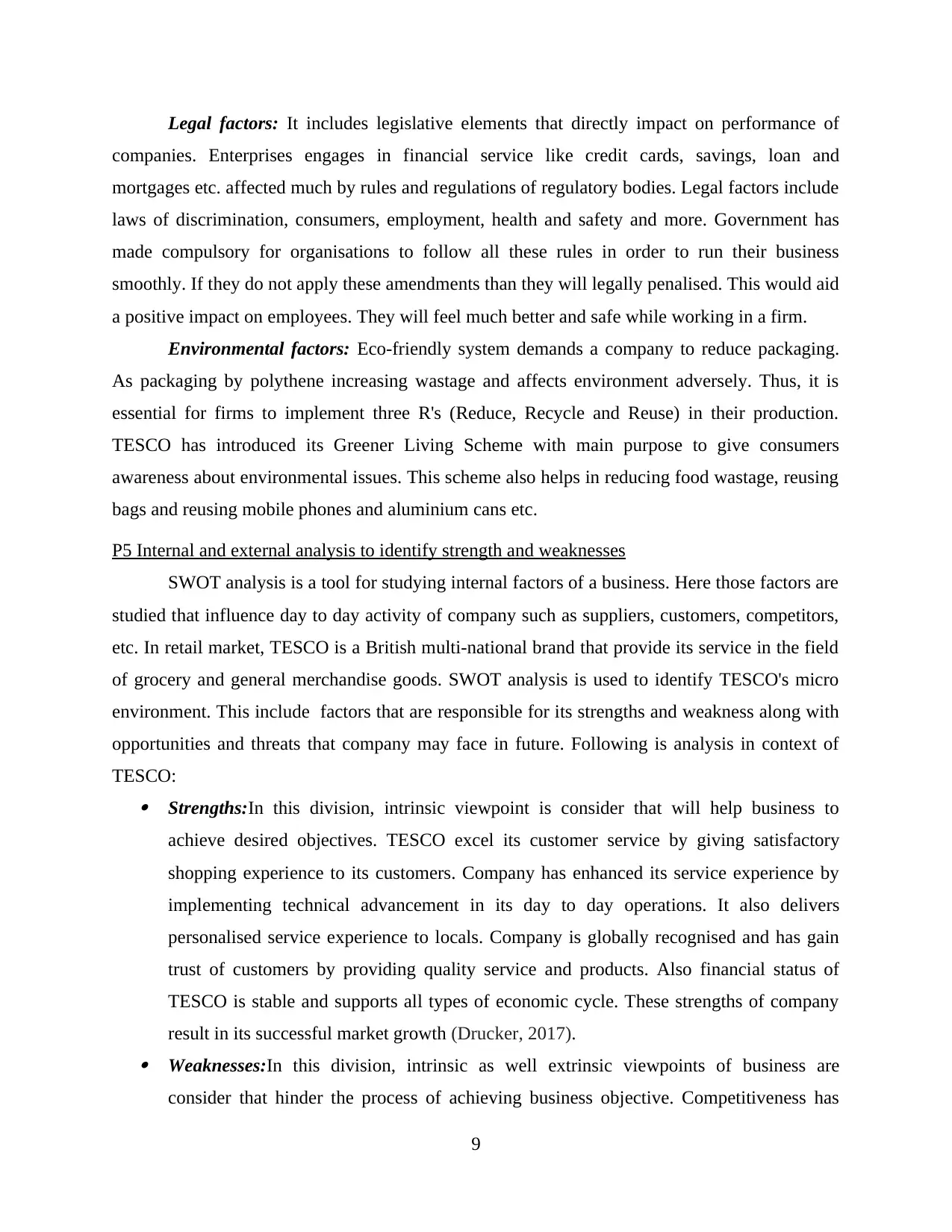
Legal factors: It includes legislative elements that directly impact on performance of
companies. Enterprises engages in financial service like credit cards, savings, loan and
mortgages etc. affected much by rules and regulations of regulatory bodies. Legal factors include
laws of discrimination, consumers, employment, health and safety and more. Government has
made compulsory for organisations to follow all these rules in order to run their business
smoothly. If they do not apply these amendments than they will legally penalised. This would aid
a positive impact on employees. They will feel much better and safe while working in a firm.
Environmental factors: Eco-friendly system demands a company to reduce packaging.
As packaging by polythene increasing wastage and affects environment adversely. Thus, it is
essential for firms to implement three R's (Reduce, Recycle and Reuse) in their production.
TESCO has introduced its Greener Living Scheme with main purpose to give consumers
awareness about environmental issues. This scheme also helps in reducing food wastage, reusing
bags and reusing mobile phones and aluminium cans etc.
P5 Internal and external analysis to identify strength and weaknesses
SWOT analysis is a tool for studying internal factors of a business. Here those factors are
studied that influence day to day activity of company such as suppliers, customers, competitors,
etc. In retail market, TESCO is a British multi-national brand that provide its service in the field
of grocery and general merchandise goods. SWOT analysis is used to identify TESCO's micro
environment. This include factors that are responsible for its strengths and weakness along with
opportunities and threats that company may face in future. Following is analysis in context of
TESCO: Strengths:In this division, intrinsic viewpoint is consider that will help business to
achieve desired objectives. TESCO excel its customer service by giving satisfactory
shopping experience to its customers. Company has enhanced its service experience by
implementing technical advancement in its day to day operations. It also delivers
personalised service experience to locals. Company is globally recognised and has gain
trust of customers by providing quality service and products. Also financial status of
TESCO is stable and supports all types of economic cycle. These strengths of company
result in its successful market growth (Drucker, 2017). Weaknesses:In this division, intrinsic as well extrinsic viewpoints of business are
consider that hinder the process of achieving business objective. Competitiveness has
9
companies. Enterprises engages in financial service like credit cards, savings, loan and
mortgages etc. affected much by rules and regulations of regulatory bodies. Legal factors include
laws of discrimination, consumers, employment, health and safety and more. Government has
made compulsory for organisations to follow all these rules in order to run their business
smoothly. If they do not apply these amendments than they will legally penalised. This would aid
a positive impact on employees. They will feel much better and safe while working in a firm.
Environmental factors: Eco-friendly system demands a company to reduce packaging.
As packaging by polythene increasing wastage and affects environment adversely. Thus, it is
essential for firms to implement three R's (Reduce, Recycle and Reuse) in their production.
TESCO has introduced its Greener Living Scheme with main purpose to give consumers
awareness about environmental issues. This scheme also helps in reducing food wastage, reusing
bags and reusing mobile phones and aluminium cans etc.
P5 Internal and external analysis to identify strength and weaknesses
SWOT analysis is a tool for studying internal factors of a business. Here those factors are
studied that influence day to day activity of company such as suppliers, customers, competitors,
etc. In retail market, TESCO is a British multi-national brand that provide its service in the field
of grocery and general merchandise goods. SWOT analysis is used to identify TESCO's micro
environment. This include factors that are responsible for its strengths and weakness along with
opportunities and threats that company may face in future. Following is analysis in context of
TESCO: Strengths:In this division, intrinsic viewpoint is consider that will help business to
achieve desired objectives. TESCO excel its customer service by giving satisfactory
shopping experience to its customers. Company has enhanced its service experience by
implementing technical advancement in its day to day operations. It also delivers
personalised service experience to locals. Company is globally recognised and has gain
trust of customers by providing quality service and products. Also financial status of
TESCO is stable and supports all types of economic cycle. These strengths of company
result in its successful market growth (Drucker, 2017). Weaknesses:In this division, intrinsic as well extrinsic viewpoints of business are
consider that hinder the process of achieving business objective. Competitiveness has
9
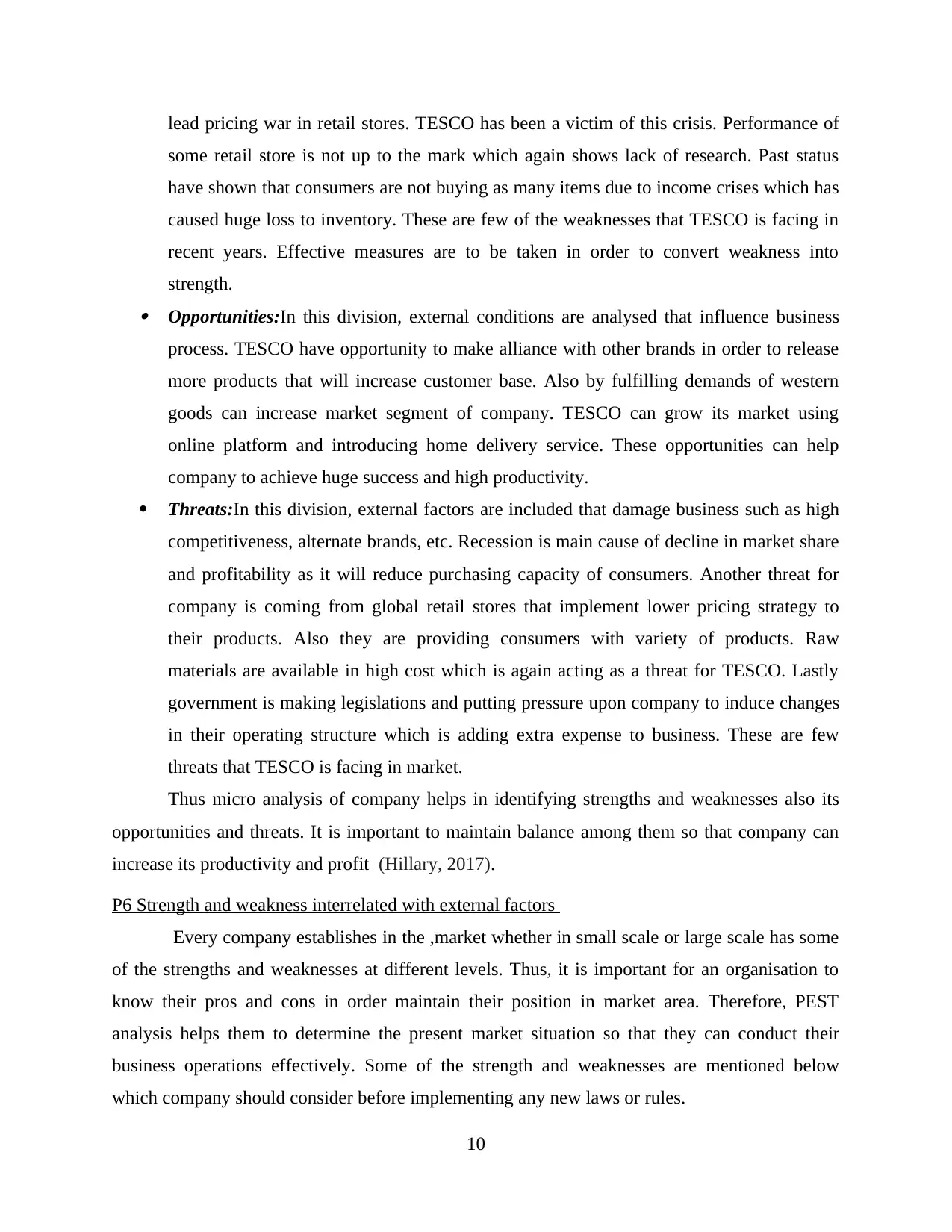
lead pricing war in retail stores. TESCO has been a victim of this crisis. Performance of
some retail store is not up to the mark which again shows lack of research. Past status
have shown that consumers are not buying as many items due to income crises which has
caused huge loss to inventory. These are few of the weaknesses that TESCO is facing in
recent years. Effective measures are to be taken in order to convert weakness into
strength. Opportunities:In this division, external conditions are analysed that influence business
process. TESCO have opportunity to make alliance with other brands in order to release
more products that will increase customer base. Also by fulfilling demands of western
goods can increase market segment of company. TESCO can grow its market using
online platform and introducing home delivery service. These opportunities can help
company to achieve huge success and high productivity.
Threats:In this division, external factors are included that damage business such as high
competitiveness, alternate brands, etc. Recession is main cause of decline in market share
and profitability as it will reduce purchasing capacity of consumers. Another threat for
company is coming from global retail stores that implement lower pricing strategy to
their products. Also they are providing consumers with variety of products. Raw
materials are available in high cost which is again acting as a threat for TESCO. Lastly
government is making legislations and putting pressure upon company to induce changes
in their operating structure which is adding extra expense to business. These are few
threats that TESCO is facing in market.
Thus micro analysis of company helps in identifying strengths and weaknesses also its
opportunities and threats. It is important to maintain balance among them so that company can
increase its productivity and profit (Hillary, 2017).
P6 Strength and weakness interrelated with external factors
Every company establishes in the ,market whether in small scale or large scale has some
of the strengths and weaknesses at different levels. Thus, it is important for an organisation to
know their pros and cons in order maintain their position in market area. Therefore, PEST
analysis helps them to determine the present market situation so that they can conduct their
business operations effectively. Some of the strength and weaknesses are mentioned below
which company should consider before implementing any new laws or rules.
10
some retail store is not up to the mark which again shows lack of research. Past status
have shown that consumers are not buying as many items due to income crises which has
caused huge loss to inventory. These are few of the weaknesses that TESCO is facing in
recent years. Effective measures are to be taken in order to convert weakness into
strength. Opportunities:In this division, external conditions are analysed that influence business
process. TESCO have opportunity to make alliance with other brands in order to release
more products that will increase customer base. Also by fulfilling demands of western
goods can increase market segment of company. TESCO can grow its market using
online platform and introducing home delivery service. These opportunities can help
company to achieve huge success and high productivity.
Threats:In this division, external factors are included that damage business such as high
competitiveness, alternate brands, etc. Recession is main cause of decline in market share
and profitability as it will reduce purchasing capacity of consumers. Another threat for
company is coming from global retail stores that implement lower pricing strategy to
their products. Also they are providing consumers with variety of products. Raw
materials are available in high cost which is again acting as a threat for TESCO. Lastly
government is making legislations and putting pressure upon company to induce changes
in their operating structure which is adding extra expense to business. These are few
threats that TESCO is facing in market.
Thus micro analysis of company helps in identifying strengths and weaknesses also its
opportunities and threats. It is important to maintain balance among them so that company can
increase its productivity and profit (Hillary, 2017).
P6 Strength and weakness interrelated with external factors
Every company establishes in the ,market whether in small scale or large scale has some
of the strengths and weaknesses at different levels. Thus, it is important for an organisation to
know their pros and cons in order maintain their position in market area. Therefore, PEST
analysis helps them to determine the present market situation so that they can conduct their
business operations effectively. Some of the strength and weaknesses are mentioned below
which company should consider before implementing any new laws or rules.
10
⊘ This is a preview!⊘
Do you want full access?
Subscribe today to unlock all pages.

Trusted by 1+ million students worldwide
1 out of 16
Related Documents
Your All-in-One AI-Powered Toolkit for Academic Success.
+13062052269
info@desklib.com
Available 24*7 on WhatsApp / Email
![[object Object]](/_next/static/media/star-bottom.7253800d.svg)
Unlock your academic potential
Copyright © 2020–2025 A2Z Services. All Rights Reserved. Developed and managed by ZUCOL.





